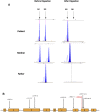Detailed genetic and clinical analysis of a novel de novo variant in HPRT1: Case report of a female patient from Saudi Arabia with Lesch-Nyhan syndrome
- PMID: 36778911
- PMCID: PMC9908584
- DOI: 10.3389/fgene.2022.1044936
Detailed genetic and clinical analysis of a novel de novo variant in HPRT1: Case report of a female patient from Saudi Arabia with Lesch-Nyhan syndrome
Abstract
Background: Hypoxanthine-guanine phosphoribosyltransferase (HPRT1) deficiency is an inborn error of purine metabolism responsible for Lesch-Nyhan syndrome (LNS). The disease is inherited in an X-linked recessive manner and predominantly affects male individuals. Female individuals can carry a mutation as heterozygotes, but typically, they are asymptomatic because of the random inactivation of the affected allele. Nevertheless, although rare, heterozygote female individuals may manifest LNS with full characteristics. Herein, we describe a female patient from Saudi Arabia with LNS. Results: The patient (a 4-year-old girl) presented with typical characteristics of the disease, which include global developmental delay, self-mutilation, hyperuricemia, hypotonia, speech delay, spasticity, and seizures. Her general biochemical laboratory results were normal except for high levels of uric acid. The abdominal MRI\MRS, mostly unremarkable, showed bilateral echogenic foci within the renal collecting system. Genetic testing (whole-exome sequencing, iterative variant filtering, segregation analysis, and Sanger sequencing) pointed a novel de novo frameshift variant in HPRT1. X-inactivation assay using HpaII showed the presence of a 100% skewed X chromosome carrying the affected allele. RT-PCR of the cDNA indicated complete loss of the expression of the normal allele. Conclusion: Our study presents a female patient who has a severe case of LNSand found to be the 15th female patient with the disease in the world. The study emphasizethe need for a streamlined protocol that will help an early and accurate diagnosis of female LNS patients to avoid unnecessary interventions that lead to costly patient care.
Keywords: HPRT1; Lesch–Nyhan syndrome; RTPCR; X-inactivation assay; de novo.
Copyright © 2023 AlBakheet, AlQudairy, Alkhalifah, Almoaily, Kaya and Rahbeeni.
Conflict of interest statement
The authors declare that the research was conducted in the absence of any commercial or financial relationships that could be construed as a potential conflict of interest.
Figures



Similar articles
-
Case report: Whole exome sequencing identifies a novel variant in the HPRT1 gene in a male with developmental delay.Front Genet. 2025 Feb 28;16:1512070. doi: 10.3389/fgene.2025.1512070. eCollection 2025. Front Genet. 2025. PMID: 40092560 Free PMC article.
-
Whole Exome Sequencing Facilitates Early Diagnosis of Lesch-Nyhan Syndrome: A Case Series.Diagnostics (Basel). 2024 Dec 13;14(24):2809. doi: 10.3390/diagnostics14242809. Diagnostics (Basel). 2024. PMID: 39767170 Free PMC article.
-
Lesch-Nyhan Syndrome in a Family with a Deletion Followed by an Insertion within the HPRT1 Gene.Nucleosides Nucleotides Nucleic Acids. 2015;34(6):442-7. doi: 10.1080/15257770.2015.1014492. Nucleosides Nucleotides Nucleic Acids. 2015. PMID: 25965333
-
Hypoxanthine-guanine phosophoribosyltransferase (HPRT) deficiency: Lesch-Nyhan syndrome.Orphanet J Rare Dis. 2007 Dec 8;2:48. doi: 10.1186/1750-1172-2-48. Orphanet J Rare Dis. 2007. PMID: 18067674 Free PMC article. Review.
-
Normal uricemia in Lesch-Nyhan syndrome and the association with pulmonary embolism in a young child-a case report and literature review.Pediatr Neonatol. 2014 Aug;55(4):312-5. doi: 10.1016/j.pedneo.2012.12.016. Epub 2013 Feb 4. Pediatr Neonatol. 2014. PMID: 23597535 Review.
Cited by
-
Case report: Whole exome sequencing identifies a novel variant in the HPRT1 gene in a male with developmental delay.Front Genet. 2025 Feb 28;16:1512070. doi: 10.3389/fgene.2025.1512070. eCollection 2025. Front Genet. 2025. PMID: 40092560 Free PMC article.
-
Whole Exome Sequencing Facilitates Early Diagnosis of Lesch-Nyhan Syndrome: A Case Series.Diagnostics (Basel). 2024 Dec 13;14(24):2809. doi: 10.3390/diagnostics14242809. Diagnostics (Basel). 2024. PMID: 39767170 Free PMC article.
-
A Report of a Child with SEC31A-Related Neurodevelopmental Disorder.Int J Mol Sci. 2025 May 30;26(11):5296. doi: 10.3390/ijms26115296. Int J Mol Sci. 2025. PMID: 40508110 Free PMC article.
-
Genetically transitional disease: conceptual understanding and applicability to rheumatic disease.Nat Rev Rheumatol. 2024 May;20(5):301-310. doi: 10.1038/s41584-024-01086-9. Epub 2024 Feb 28. Nat Rev Rheumatol. 2024. PMID: 38418715 Review.
-
Case report: Clinical and genetic characterization of a novel ALDH7A1 variant causing pyridoxine-dependent epilepsy, developmental delay, and intellectual disability in two siblings.Front Psychiatry. 2024 Dec 23;15:1501238. doi: 10.3389/fpsyt.2024.1501238. eCollection 2024. Front Psychiatry. 2024. PMID: 39763688 Free PMC article.
References
-
- Aldhalaan H., AlBakheet A., AlRuways S., AlMutairi N., AlNakiyah M., AlGhofaili R., et al. (2021). A novel GEMIN4 variant in a consanguineous family leads to neurodevelopmental impairment with severe microcephaly, spastic quadriplegia, epilepsy, and cataracts. Genes (Basel) 13, 92. 10.3390/genes13010092 - DOI - PMC - PubMed
-
- Aral B., de Saint Basile G., Al-Garawi S., Kamoun P., Ceballos-Picot I. (1996). Novel nonsense mutation in the hypoxanthine guanine phosphoribosyltransferase gene and nonrandom X-inactivation causing Lesch-Nyhan syndrome in a female patient. Hum. Mutat. 7, 52–58. 10.1002/(SICI)1098-1004(1996)7:1<52::AID-HUMU7>3.0.CO;2-R - DOI - PubMed
Publication types
LinkOut - more resources
Full Text Sources
Miscellaneous

